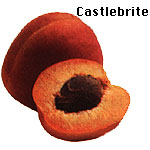
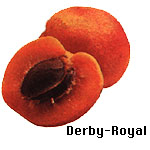
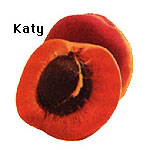


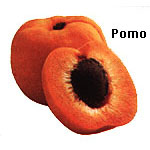

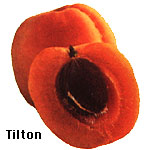
FoodFood InformationFruitDeciduous
The apricot originated in China thousands of years ago. This drupe gradually
worked its way westward via camel caravans, was transplanted and flourished
throughout Asia. Botanically it is identified as Prunus armeniaca and used
to be known as an Armenian apple or peach. Apricots were referred to in
Greek mythology as the Golden Apples of Hesperides.
When the apricot was transplanted to California, it found an ideal home.
California produces a huge annual crop, most of which is packed in tins
or sold as dried fruit. Washington State also grows excellent apricots,
and in recent years its crop has shown significant increases in tonnage.
The apricot, a freestone fruit, features a beautiful orange color, a velvety
skin, a most delicate flavor and texture, and a lovely fragrance. Of all
summer deciduous fruits they are by far the most fragile. At their flavor
best when tree-ripened, apricots are like golden balls of sweet juice. A
truly ripe apricot is almost like a liquid nectar in texture. However, when
they are fully ripened they can't withstand the rigors of packaging, transportation,
or marketing. So apricots picked to ship to other areas, even around the
corner, are harvested while quite firm. If they are picked while firm but
with nice color, they will ripen properly at room temperature and be quite
flavorful. If the growers play it too safe and pick the fruit when it is
quite green, rather than color up and ripen, the apricots will shrink and
shrivel and have little or no flavor. Purchase fresh apricots that have
high color. Those that are light green may or may not color up. Those that
are dark green will never ripen.
"Cots," as apricots are known to the produce trade, have an all
too short season (almost as short as the cherry season). Those grown in
California and Washington are at peak of season in May, June, and July.
In December and January we import a few from the Southern Hemisphere and,
considering the distance they have to travel, they arrive in surprisingly
good condition.
Until a few years ago, only a few varieties of apricots were shipped to
market. The old standbys included the Royals, Tiltons, Perfections,
and Moorpacks. However, recently we have been deluged with many new,
very colorful varieties. One of these, called the King, is almost
as big as a peach. Another fine-looking new apricot is the Flaming Gold
variety. It's still too early to pass judgment on these new kids on the
block, but some of them look very promising.








WHEN TO BUY: At peak: July and August
WHAT TO LOOK FOR: not bruised, high-color (orange) fruit
HOW TO STORE: Ripen at room temperature; refrigerate when ready to eat (soft
to the touch)
Deamer 5/97